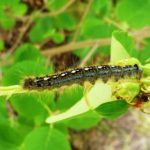Winter wheat and fall rye harvest is underway in Manitoba. To date, preliminary reports indicate winter wheat yields range from 60 to 95 bu/acre, and fall rye yields range from 40 to 90 bu/acre. Weekend thunderstorms resulted in variable amounts of precipitation, hail activity and lodging of crops across some areas of Manitoba. The majority
Manitoba Crop Report and Crop Weather report: No. 14
Conditions as of August 2, 2016

Lygus bugs reach economic thresholds in canola fields
Manitoba Insect & Disease summary for July 27
Summary Insects: Lygus bugs around economic threshold levels have been noted in a few canola fields in eastern Manitoba. Banded sunflower moth adults have also been noted; late bud to early bloom stage is when sunflowers should be monitored for seed feeding insects like banded sunflower moth, Lygus bugs, and red sunflower seed weevils. Trace levels of soybean aphid have been found on soybeans near Fannystelle and Lac du Bonnet;
Manitoba Crop Report and Crop Weather report: No. 13
Conditions as of July 25, 2016
Severe weather systems containing strong winds, tornadoes, heavy rains and hail passed through several areas of Manitoba. Field and forage crops, as well shelterbelts and farm infrastructure, were impacted by the storms. Crop damage, including lodging and stalk breakage, ranges from light to severe. Assessments are continuing. The warmer temperatures benefitted all crops, particularly the
Manitoba Crop Report and Crop Weather report: No. 12
Conditions as of July 18, 2016
Generally good growing conditions continue to advance crops across Manitoba. Localized thunderstorms did result in significant precipitation amounts and crop lodging in some areas of the province. Majority of acres and crop types are in the flowering and grain fill stages of development. Disease pressure and insect activity continues to be monitored as the growing

Alfalfa weevil levels rapidly decline, high levels of pea aphids still seen
Manitoba Insect & Disease summary for July 13
Summary Insects: Levels of alfalfa weevil larvae are rapidly declining in some alfalfa fields as the larvae mature to pupae. Pea aphid levels are still a concern in some pea fields. Aphid levels are being monitored carefully in some cereal fields; high levels of natural enemies have also been noted in some of these fields and may be
Manitoba Crop Report and Crop Weather report: No. 11
Conditions as of July 11, 2016
Areas of Manitoba saw thunderstorm activity resulting in heavy rainfall, strong winds and hail. Assessments of crop damage due to hail is continuing. Crop lodging also occurred, particularly in spring and winter cereal crops. Fungicide applications continue in many crop types to manage disease risk. Livestock producers continue to make slow progress with first cut
Manitoba Crop Report and Crop Weather report: No. 10
Conditions as of July 4, 2016
The warmer and drier weather conditions were welcomed by Manitoba producers. All crop types, particularly the warm season crops including grain corn and soybeans, are benefiting from the warmer weather. The more favourable weather conditions are allowing some acres impacted by excess moisture to recover. However, continuing wet field conditions and symptoms of excess moisture
Alfalfa weevil levels seen high, crop scouting for diseases still needed
Manitoba Insect & Disease summary for June 29
Summary Insects: Alfalfa weevil is still at high levels in some alfalfa fields. Some alfalfa hay fields are being cut early as a result. Pea aphid levels are near or above economic threshold in some pea fields, although levels are sporadic as other fields have quite low levels. Plant pathogens: Scouting should be continued for all crop
Manitoba Crop Report and Crop Weather report: No. 9
Conditions as of June 27, 2016
Severe weather systems containing strong winds, heavy rains and hail passed through several regions of Manitoba over the weekend. Damage to crops from hail and strong winds range from light to severe with assessments continuing over the next several days. The wet weather conditions continue to impact crops in many areas of the province as

Cutworms growing larger, stripe rust detected
Manitoba Insect & Disease summary for June 8
Insects Cutworms are getting larger and have been an issue in some fields. The highest level of damage appears to be in the Northwest, where there has been some reseeding because of cutworm feeding. Flea beetle feeding continues, although foliar use of insecticides for flea beetle management has not been widespread. In many fields plants are now getting to stages more tolerant to feeding by flea beetles. Plant Pathogens Stripe rust has been detected

